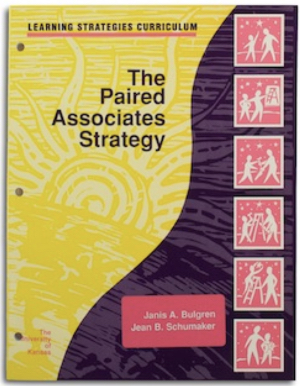The Paired Associates Strategy

The Paired Associates Strategy helps students independently and in an organized way approach large bodies of information they need to master. Using the strategy, students identify pairs or groups of items that are important to learn, such as names and events, places and events, or names and accomplishments. They create study cards, create a mnemonic device for each card, and use the study cards to learn the information.
Instruction in this strategy produces relatively quick and significant performance gains for most students. Because of this, it builds low-achieving students' confidence in their test-taking abilities and enables them to improve their grades in required courses.
In studies, before students learned the Paired Associates Strategy, they correctly answered an average of 18 percent of test questions related to paired information when that information was identified for them. After they mastered the strategy, they correctly answered an average of 85 percent of similar questions. When students were given reading passages to study on their own--and had to identify paired information independently as well as learn the information--they answered an average of 22 percent of test questions correctly before instruction in the strategy compared to 76 percent after mastering the strategy.
Author(s):Janis A. Bulgren, Jean B. Schumaker
Publication and Purchasing Information: University of Kansas, Center for Research on Learning (1996) / KU CRL Online Store
Resources:
Research Articles:
- Bulgren, J.A., Hock, M.F., Schumaker, J.B., & Deshler, D.D. (1995). The effects of instruction in a paired associates strategy on the information mastery performance of students with learning disabilities. Learning Disabilities Research & Practice, 10(1), 22-37. High school students in this multiple baseline across student design study were taught the Paired Associates Strategy for 20-30 minutes per day for six months.
The Story Behind the Paired Associates Strategy from author Jan Bulgren:
As I worked on developing new ways of teaching, I realized that more and more emphasis is being put on deep comprehension demands in our schools and the real world. I learned that deep comprehension begins with a base of facts and concepts. Then, these facts and concepts are organized and used to manipulate relationships. Finally, these understandings are used to solve real-world problems. Therefore, I came to understand that the learning of facts and concepts is never an end in itself. It is a springboard to deep comprehension and application of understandings.
I brought this understanding to the task of developing a way to help students learn facts. In addition, before the development of and research on the instructional package for teaching the Paired Associates Strategy, I had previously worked with teachers as they planned to teach students approaches to acquiring conceptual knowledge with the Concept Mastery Routine. During this process, I began to think about the scope of knowledge students need to be able to learn concepts. Research tells us that a good factual foundation is needed in order for students to acquire and use concepts. This understanding helped our research team to conduct research on how to help students recall important information with the Paired Associates Strategy. We learned that mnemonic devices could support student learning of factual information as a basis for deep comprehension and application of information.
The Paired Associates Strategy was needed to ensure that students could recall factual information. Four different ways of learning information were incorporated into this strategy: (1) forming mental images; (2) making familiar associations; (3) developing keyword and peg- word mnemonic devices; and (4) translating numbers to an alphabetic code.
Author's Thoughts About Paired Associates Instruction:
The development of four ways to help students learn important information clarified my understandings that less is more — that is, if there are a variety of ways to achieve a goal, then we should start with the easiest.
Many strategies require several layers of elaboration to ensure learning. However, by sequencing the four Paired Associates strategies from easiest to the more complex, the goal was to help students become more efficient learners. As a result, the four strategies begin with those requiring less elaboration, layers of memory, mnemonic devices, and strategic steps.
Therefore, the first strategy, which requires visual imagery, simply requires putting two pictures together, that is to “Create a picture.” The second also requires that picture — with an added layer of finding something familiar for the picture, that is, students have to “Relate to something familiar.”
The third, the “peg word” or key word strategy, requires identifying key syllables to facilitate recall. This requires more elaboration and would be chosen in preference to one of the first two only when absolutely necessary due to the added layers of cognitive requirements involved in isolating syllables as well as creating pictures.
Finally, the last strategy, which involves coding, is even more elaborate because it requires transformation of numbers to letters and creating mnemonic devices. However, these latter strategies are, indeed, needed at times, and available for use. Judicious choice of the most appropriate strategy is paramount to efficient and effective recall strategies.
Teacher Feedback on the Paired Associates Strategy:
Feedback from teachers who participated in our field test indicated that they had a new appreciation for how they themselves learned, how their diverse student population learned, and how one size does not fit all students or all types of information to be remembered. Students clearly need options among which they can choose to facilitate their learning of factual information, and this strategy provides them with those options.
This product is available through the KUCRL Shop.
Please note that professional development, coaching, and infrastructure support are essential components to effective implementation of SIM instructional tools and interventions. It is highly recommended that you work with a SIM professional developer. See the SIM Event list for sessions or email simpd@ku.edu to learn more.
An accessible version of the documents on this site will be made available upon request. Please contact the KU CRL Professional Development Research Institute, at simpd@ku.edu to request the document be made available in an accessible format.